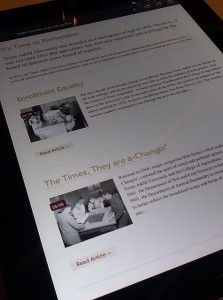Whether your business is paying attention to mobile or not your customers certainly are.
Recent research from comScore shows mobile is now the leading digital platform, with activity on mobile devices accounting for 60% of U.S. digital media time.
For this reason alone your business must have a strategy for engaging customers via mobile.
At a minimum this means businesses will need to make sure their web site and email perform on mobile devices. Web design companies in Phoenix are generally utilizing responsive design to fulfill this need.
 Responsive design know the size of device is displaying the content and delivers content optimized for that screen size.
Responsive design know the size of device is displaying the content and delivers content optimized for that screen size.
How important is it that your web site be responsive? Google has recently changed its rankings so that if your web site is not responsive it will affect your ranking.
While mobile should be part of your marketing and business communications plan, you should begin by developing a strategy before jumping in feet first. A key component of this is developing an understanding with how your customers want to interact with you via mobile.
A simple way to start doing this involve reviewing the analytics from your current web site, look at where your traffic is coming from by type of device. You will see patterns of how your customers engage with with your web site.
A common way to analyze the data by creating customer profiles for various customer segments that engage with your web site, these are called personas. By understanding how these groups engage with your brand via digital you can tailor your web site and marketing campaigns to them. Your customers will let you know how to engage with them.
Remember that your site must be simple to navigate. Modern mobile users a quick to abandon a site if they cannot navigate your site quickly and easily. Navigation is one of the key factors for a web sites success on mobile devices.
Customer’s generally expect mobile web sites to load quickly. Pay attention to your site’s load time. Customers will give up on slow loading sites. One way to help with this is by not having an over-abundance of graphics on your site. Images should improve your user experience, not just be there for aesthetic reasons.
Photo: Jason Weaver (Flikr) http://bit.ly/1f2Ggrc
In 2015 businesses simply cannot ignore that their users are viewing their web site on mobile devices. Responsive web design has emerged as the de facto trend as it allows sites to adapt to smaller screens.
This makes the need for responsive design critical, as it adapts your web site design to both the size and connection speed of smaller devices.
 A few handy tips can greatly improve the performance of you responsive web site.
A few handy tips can greatly improve the performance of you responsive web site.
Mobile First
A mobile first strategy involve designing the mobile site first and then scaling up for tablets and desktop computers. If your web site looks good and is easy to read on a mobile device it won’t be hard to read on a desktop. Starting with mobile allows you to work down your site to its essentials elements. This allows you to streamline and focus your message. Once you have locked down a design that excels on the small display of a mobile device it can easily be expanded to fit larger areas.
Navigation
Navigation is one of the most critical elements of a responsive web site. Success and failure often depends on the user experience created by the sites’ navigation. Users no longer will stumble around web sites trying to find what they are looking for. In this day and age users expect interfaces to be intuitive and easy to use. Good sites typically have self explanatory navigation.
Simplify
Desktop sites for the longest time favored complicated visual designs with massive amounts of content and many navigation options. These days streamlined, clean designs with plenty of white space are recommended for responsive sites. Not only to customers tend to appreciate the speed with which these simplified designs load but they the minimal design tends to give sites a modern look that sets them apart from older designs. It is important that sites load quickly on mobile devices and simplifying design is one of the best ways to do this.
Responsive web sites should display a consistent look and feel across mobile, laptops and desktop computers.
You can no longer ignore responsive design. It is necessary for any business.
Photo: Serge Kij (Flikr) http://bit.ly/1JStB7F
In a recent survey by IAB, 32% of participants now have mobile marketing budgets exceeding $300,000 (300 brand marketer participated). One year ago only 7% made the same claim. Mobile budgets are expected to increase in the future as nearly three fourths of participants predict that their spending on mobile advertising will continue to increase over the next few years. A significant number, 19%, stated that they felt that their mobile budgets will increase by 50% or more over that same period.
“Studies like this serve to drive home the point that companies need to make mobile a top priority right now to keep up with their competition,” says Kimber Johnson, Managing Director, Vanity Point. “with advertising it is important to put your message where consumers eyes are and right now they are on their mobile devices.”
Furthermore, in the survey, participants were asked what they ranked as “very important” or “important” mobile advertising developments and 87% said responsive design followed by HTML5 (77%) and mobile native advertising (74%).
Responsive web design is a hot trend right now that allows business to address the needs of a mobile web site without building a separate web site for mobile devices. “We see several of our customers opting for responsive web design right now,” continues Kimber Johnson, “it is an affordable and effective first step to address mobile marketing needs”.